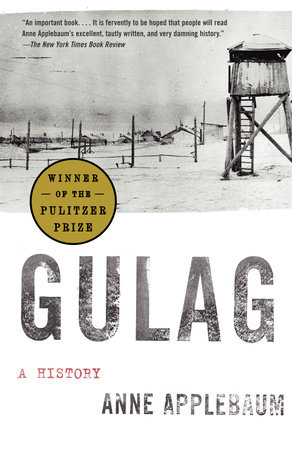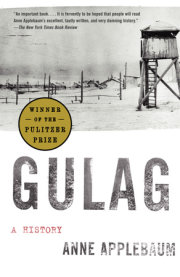Chapter 1
BOLSHEVIK BEGINNINGSBut your spine has been smashed,
My beautiful, pitiful era,
And with an inane smile
You look back, cruel and weak,
Like an animal past its prime,
At the prints of your own paws.--Osip Mandelstam, "Vek"1
One of my goals is to destroy the myth that the cruelest era of repression began in 1936-37. I think that in future, statistics will show that the wave of arrests, sentences and exile had already begun at the beginning of 1918, even before the official declaration, that autumn, of the "Red Terror." From that moment, the wave simply grew larger and larger, until the death of Stalin . . .--Dmitrii Likhachev,
Vospominaniya2
In the year 1917, two waves of revolution rolled across Russia, sweeping Imperial Russian society aside as if it were destroying so many houses of cards. After Czar Nicholas II abdicated in February, events proved extremely difficult for anyone to halt or control. Alexander Kerensky, the leader of the first post-revolutionary Provisional Government, later wrote that, in the void following the collapse of the old regime, "all existing political and tactical programs, however bold and well conceived, appeared hanging aimlessly and uselessly in space."3
But although the Provisional Government was weak, although popular dissatisfaction was widespread, although anger at the carnage caused by the First World War ran high, few expected power to fall into the hands of the Bolsheviks, one of several radical socialist parties agitating for even more rapid change. Abroad, the Bolsheviks were scarcely known. One apocryphal tale illustrates foreign attitudes very well: in 1917, so the story goes, a bureaucrat rushed into the office of the Austrian Foreign Minister, shouting, "Your Excellency, there has been a revolution in Russia!" The minister snorted. "Who could make a revolution in Russia? Surely not harmless Herr Trotsky, down at the Café Central?"
If the nature of the Bolsheviks was mysterious, their leader, Vladimir Ilyich Ulyanov--the man the world would come to know by his revolutionary pseudonym, "Lenin"--was even more so. During his many years as an émigré revolutionary, Lenin had been recognized for his brilliance, but also disliked for his intemperance and his factionalism. He picked frequent fights with other socialist leaders, and had a penchant for turning minor disagreements over seemingly irrelevant matters of dogma into major arguments.4
In the first months following the February Revolution, Lenin was very far from holding a position of unchallenged authority, even within his own Party. As late as mid-October 1917, a handful of leading Bolsheviks continued to oppose his plan to carry out a coup d'état against the Provisional Government, arguing that the Party was unprepared to take power, and that it did not yet have popular support. He won the argument, however, and on October 25 the coup took place. Under the influence of Lenin's agitation, a mob sacked the Winter Palace. The Bolsheviks arrested the ministers of the Provisional Government. Within hours, Lenin had become the leader of the country he renamed Soviet Russia.
Yet although Lenin had succeeded in taking power, his Bolshevik critics had not been entirely wrong. The Bolsheviks were indeed wildly unprepared. As a result, most of their early decisions, including the creation of the one-party state, were taken to suit the needs of the moment. Their popular support was indeed weak, and almost immediately they began to wage a bloody civil war, simply in order to stay in power. From 1918, when the White Army of the old regime regrouped to fight the new Red Army--led by Lenin's comrade, "Herr Trotsky" from the "Café Central"--some of the most brutal fighting ever seen in Europe raged across the Russian countryside. Nor did all of the violence take place in battlefields. The Bolsheviks went out of their way to quash intellectual and political opposition in any form it took, attacking not only the representatives of the old regime but also other socialists: Mensheviks, Anarchists, Social Revolutionaries. The new Soviet state would not know relative peace until 1921.5
Against this background of improvisation and violence, the first Soviet labor camps were born. Like so many other Bolshevik institutions, they were created ad hoc, in a hurry, as an emergency measure in the heat of the civil war. This is not to say the idea had no prior appeal. Three weeks before the October Revolution, Lenin himself was already sketching out an admittedly vague plan to organize "obligatory work duty" for wealthy capitalists. By January 1918, angered by the depth of the anti-Bolshevik resistance, he was even more vehement, writing that he welcomed "the arrest of millionaire-saboteurs traveling in first- and second-class train compartments. I suggest sentencing them to half a year's forced labor in a mine."6
Lenin's vision of labor camps as a special form of punishment for a particular sort of bourgeois "enemy" sat well with his other beliefs about crime and criminals. On the one hand, the first Soviet leader felt ambivalent about the jailing and punishment of traditional criminals--thieves, pickpockets, murderers--whom he perceived as potential allies. In his view, the basic cause of "social excess" (meaning crime) was "the exploitation of the masses." The removal of the cause, he believed, "will lead to the withering away of the excess." No special punishments were therefore necessary to deter criminals: in time, the Revolution itself would do away with them. Some of the language in the Bolsheviks' first criminal code would have thus warmed the hearts of the most radical, progressive criminal reformers in the West. Among other things, the code decreed that there was "no such thing as individual guilt," and that punishment "should not be seen as retribution."7
On the other hand, Lenin--like the Bolshevik legal theorists who followed in his wake--also reckoned that the creation of the Soviet state would create a new kind of criminal: the "class enemy." A class enemy opposed the Revolution, and worked openly, or more often secretly, to destroy it. The class enemy was harder to identify than an ordinary criminal, and much harder to reform. Unlike an ordinary criminal, a class enemy could never be trusted to cooperate with the Soviet regime, and required harsher punishment than would an ordinary murderer or thief. Thus in May 1918, the first Bolshevik "decree on bribery" declared that: "If the person guilty of taking or offering bribes belongs to the propertied classes and is using the bribe to preserve or acquire privileges, linked to property rights, then he should be sentenced to the harshest and most unpleasant forced labor and all of his property should be confiscated."8
From the very earliest days of the new Soviet state, in other words, people were to be sentenced not for what they had done, but for who they were.
Unfortunately, nobody ever provided a clear description of what, exactly, a "class enemy" was supposed to look like. As a result, arrests of all sorts increased dramatically in the wake of the Bolshevik coup. From November 1917, revolutionary tribunals, composed of random "supporters" of the Revolution, began convicting random "enemies" of the Revolution. Prison sentences, forced-labor terms, and even capital punishment were arbitrarily meted out to bankers, to merchants' wives, to "speculators"--meaning anyone engaged in independent economic activity--to former Czarist-era prison warders and to anyone else who seemed suspicious.9
The definition of who was and who was not an "enemy" also varied from place to place, sometimes overlapping with the definition of "prisoner of war." Upon occupying a new city, Trotsky's Red Army frequently took bourgeois hostages, who could be shot in case the White Army returned, as it often did along the fluctuating lines of the front. In the interim they could be made to do forced labor, often digging trenches and building barricades.10 The distinction between political prisoners and common criminals was equally arbitrary. The uneducated members of the temporary commissions and revolutionary tribunals might, for example, suddenly decide that a man caught riding a tram without a ticket had offended society, and sentence him for political crimes.11 In the end, many such decisions were left up to the policeman or soldiers doing the arresting. Feliks Dzerzhinsky, founder of the Cheka--Lenin's secret police, the forerunner of the KGB--personally kept a little black notebook in which he scribbled down the names and addresses of random "enemies" he came across while doing his job.
These distinctions would remain vague right up until the collapse of the Soviet Union itself, eighty years later. Nevertheless, the existence of two categories of prisoner--"political" and "criminal"--had a profound effect on the formation of the Soviet penal system. During the first decade of Bolshevik rule, Soviet penitentiaries even split into two categories, one for each type of prisoner. The split arose spontaneously, as a reaction to the chaos of the existing prison system. In the very early days of the Revolution, all prisoners were incarcerated under the jurisdiction of the "traditional" judicial ministries, first the Commissariat of Justice, later the Commissariat of the Interior, and placed in the "ordinary" prison system. That is, they were thrown into the remnants of the Czarist system, usually into the dirty, gloomy stone prisons which occupied a central position in every major town. During the revolutionary years of 1917 to 1920, these institutions were in total disarray. Mobs had stormed the jails, self-appointed commissars had sacked the guards, prisoners had received wide-ranging amnesties or had simply walked away.13
By the time the Bolsheviks took charge, the few prisons that remained in operation were overcrowded and inadequate. Only weeks after the Revolution, Lenin himself demanded "extreme measures for the immediate improvement of food supplies to the Petrograd prisons."14 A few months later, a member of the Moscow Cheka visited the city's Taganskaya prison and reported "terrible cold and filth," as well as typhus and hunger. Most of the prisoners could not carry out their forced-labor sentences because they had no clothes. A newspaper report claimed that Butyrka prison in Moscow, designed to hold 1,000 prisoners, already contained 2,500. Another newspaper complained that the Red Guards "unsystematically arrest hundreds of people every day, and then don't know what to do with them."15
Overcrowding led to "creative" solutions. Lacking anything better, the new authorities incarcerated prisoners in basements, attics, empty palaces, and old churches. One survivor later remembered being placed in the cellar of a deserted house, in a single room with fifty people, no furniture, and little food: those who did not get packages from their families simply starved.16 In December 1917, a Cheka commission discussed the fate of fifty-six assorted prisoners--"thieves, drunks and various 'politicals' "--who were being kept in the basement of the Smolny Institute, Lenin's headquarters in Petrograd.17
Not everyone suffered from the chaotic conditions. Robert Bruce Lockhart, a British diplomat accused of spying (accurately, as it happened), was imprisoned in 1918 in a room in the Kremlin. He occupied himself playing Patience, and reading Thucydides and Carlyle. From time to time, a former imperial servant brought him hot tea and newspapers.18
But even in the remaining traditional jails, prison regimes were erratic, and prison wardens were inexperienced. A prisoner in the northern Russian city of Vyborg discovered that, in the topsy-turvy post-revolutionary world, his former chauffeur had become a prison guard. The man was delighted to help his former master move to a better, drier cell, and eventually to escape. One White Army colonel also recalled that in the Petrograd prison in December 1917 prisoners came and left at will, while homeless people slept in the cells at night. Looking back on this era, one Soviet official remembered that "the only people who didn't escape were those who were too lazy."20
The disarray forced the Cheka to come up with new solutions: the Bolsheviks could hardly allow their "real" enemies to enter the ordinary prison system. Chaotic jails and lazy guards might be suitable for pickpockets and juvenile delinquents, but for the saboteurs, parasites, speculators, White Army officers, priests, bourgeois capitalists, and others who loomed so large in the Bolshevik imagination, more creative solutions were needed.
A solution was found as early as June 4, 1918, Trotsky called for a group of unruly Czech war prisoners to be pacified, disarmed, and placed in a
kontslager: a concentration camp. Twelve days later, in a memorandum addressed to the Soviet government Trotsky again spoke of concentration camps, outdoor prisons in which "the city and village bourgeoisie . . . shall be mobilized and organized into rear-service battalions to do menial work (cleaning barracks, camps, streets, digging trenches, etc.). Those refusing will be fined, and held under arrest until the fine is paid."21
In August, Lenin made use of the term as well. In a telegram to the commissars of Penza, site of an anti-Bolshevik uprising, he called for "mass terror against the
kulaks [rich peasants], priests and White Guards" and for the "unreliable" to be "locked up in a concentration camp outside town."22 The facilities were already in place. During the summer of 1918--in the wake of the Brest-Litovsk Treaty which ended Russia's participation in the First World War--the regime freed two million war prisoners. The empty camps were immediately turned over to the Cheka.23
At the time, the Cheka must have seemed the ideal body to take over the task of incarcerating "enemies" in "special" camps. A completely new organization, the Cheka was designed to be the "sword and shield" of the Communist Party, and had no allegiance to the official Soviet government or any of its departments. It had no traditions of legality, no obligation to obey the rule of law, no need to consult with the police or the courts or the Commissar of Justice. Its very name spoke of its special status: the All-Russian Extraordinary Commission for Combating Counter-Revolution and Sabotage--or, using the Russian abbreviation for "Extraordinary Commission"--the Ch-K, or Cheka. It was "extraordinary" precisely because it existed outside of "ordinary" legality.
Almost as soon as it was created, the Cheka was given an extraordinary task to carry out. On September 5, 1918, Dzerzhinsky was directed to implement Lenin's policy of Red Terror. Launched in the wake of an assassination attempt on Lenin's life, this wave of terror--arrests, imprisonments, murders--more organized than the random terror of the previous months, was in fact an important component of the civil war, directed against those suspected of working to destroy the Revolution on the "home front." It was bloody, it was merciless, and it was cruel--as its perpetrators wanted it to be.
Krasnaya Gazeta, the organ of the Red Army, described it: "Without mercy, without sparing, we will kill our enemies in scores of hundreds. Let them be thousands, let them drown themselves in their own blood. For the blood of Lenin . . . let there be floods of blood of the bourgeoisie--more blood, as much as possible . . ."24
The Red Terror was crucial to Lenin's struggle for power. Concentration camps, the so-called "special camps," were crucial to the Red Terror. They were mentioned in the very first decree on Red Terror, which called not only for the arrest and incarceration of "important representatives of the bourgeoisie, landowners, industrialists, merchants, counter-revolutionary priests, anti-Soviet officers" but also for their "isolation in concentration camps."25 Although there are no reliable figures for numbers of prisoners, by the end of 1919 there were twenty-one registered camps in Russia. At the end of 1920 there were 107, five times as many.26
Notes:
1. From
Stekla vechnosti, pp. 172-73.
2. Likhachev,
Vosppminania, p. 118.
3. Pipes, pp. 336-37.
4. See, for example, Service,
Lenin.5. Popies, pp. 439-505; Figes, pp. 474-551.
6. Geller, pp. 23 and 24.
7. Jakobson, pp. 18-26.
8.
Dekrety, vol. II, pp. 241-42, and vol. III, p. 80. Also Geller, p. 10; Pipes, pp. 793-800.
9. Jakobson, pp. 18-26; Decree "On Revolutionart Tribunals," in
Sbornik, December 19, 1917, pp. 9-10.
10. Hoover, Melgunov Collection, Box 1, Folder 63.
11. Okhotin and Roginsky, p. 13.
12. RGASPI, 76/3/1 and 13.
13. Jakobson, pp. 10-17; Okhotin and Roginsky, pp. 10-24.
14.
Dekrety, vol. 1, p. 401
15. Hoover, Melgunov Collection, Box 1, Folder 4.
16. Anonymous,
Vo vlasti Gubcheka, pp. 3-11.
17. Hoover, Melgunov Collection, Box 1, Folder.
18. Lockhart, pp. 326-45.
19. S. G. Eliseev, "Tyuremnyi dnevnik," in
Uroki, pp. 17-19.
20. Okhotin and Roginsky, p. 11.
21. Geller, p. 43.
22. Ibid., p. 44; Leggett, p. 103.
23. Initially, the Cheka were put in charge of the camps in conjunction with the Central Collegium for War Prisoners and Refugees (
Tsentroplenbezh). Okhotin and Roginskii, p. 11.
24. Leggett, p. 108.
25. Decree "On Red Terror," in
Sbornik, September 5, 1918, p. 11.
26. Ivanova,
Labor Camp Socialism, p. 13.
Copyright © 2003 by Anne Applebaum. All rights reserved. No part of this excerpt may be reproduced or reprinted without permission in writing from the publisher.









